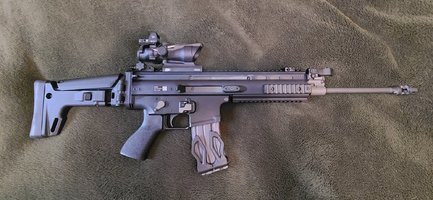Acogs are big moneyI do not like it’s price, very much. All the rest is more than fine. But a $1k+ price is not ok.
-
If you enjoy the forum please consider supporting it by signing up for a NES Membership The benefits pay for the membership many times over.
You are using an out of date browser. It may not display this or other websites correctly.
You should upgrade or use an alternative browser.
You should upgrade or use an alternative browser.
What is Your Favorite ACOG
- Thread starter 22lr
- Start date
I know this is not an answer to the question you’ve asked, but if it was me, I’d go with a Romeo 4t ($5-600) and a Juliet4 magnifier. You’d have choice of reticle with 100 000 hours battery life, and magnification on demand. Much more versatile than an ACOG.
Mesatchornug
NES Member
the problem, for the OP, is that red dots don't work for many folks with astigmatism. If you can use a red dot, this seems like a great option.I know this is not an answer to the question you’ve asked, but if it was me, I’d go with a Romeo 4t ($5-600) and a Juliet4 magnifier. You’d have choice of reticle with 100 000 hours battery life, and magnification on demand. Much more versatile than an ACOG.
The SIG Romeo 4t has reticle choice as a feature. The “circle+crosshair” or even the plain crosshairs doesn’t bloom nearly as much as a simple dot for people with astigmatism. And the 4t is approved by the FBI, SAS, and CAG Delta. That’s quite the endorsement right there. Either way, I find the fixed 4x of the ACOG quite limiting. LPVOs have made a huge leap in technology over the last 5 years or so. I think a 1-6 or 1-8 is where it’s at for a GP rifle, but again, it has nothing to do with the OP’s question. Sorry for getting the thread off the rail.the problem, for the OP, is that red dots don't work for many folks with astigmatism. If you can use a red dot, this seems like a great option.
Mesatchornug
NES Member
That's super useful info. Thanks! (Having similar issues to OP I have a couple dots that are of little use to me. Probably going to go with a LPVO for exactly the reasons you point out)The SIG Romeo 4t has reticle choice as a feature. The “circle+crosshair” or even the plain crosshairs doesn’t bloom nearly as much as a simple dot for people with astigmatism. And the 4t is approved by the FBI, SAS, and CAG Delta. That’s quite the endorsement right there. Either way, I find the fixed 4x of the ACOG quite limiting. LPVOs have made a huge leap in technology over the last 5 years or so. I think a 1-6 or 1-8 is where it’s at for a GP rifle, but again, it has nothing to do with the OP’s question. Sorry for getting the thread off the rail.
I am still lost on what OP wants. for a tactical weapon with a task to hit human size targets any 3x or 4x prism based optic is best - an ACOG, or vortex, or primary arms, or AT3 - all got OK prisms to choose from with BDC reticles.the problem, for the OP, is that red dots don't work for many folks with astigmatism. If you can use a red dot, this seems like a great option.
to hunt - there are plenty of lightweight 3-15 or 4-16 scopes.
for a competition or 3 gun there are other scopes, with 1- on the wide end - was discussed here in plenty of details. my interests are precision shooting and hunting only, so, i typically ignore red dots or prisms on rifles (but got one on the tavor now), so - i guess it is really up to OP to decide what interests him the best, and drive a decision from that angle.
Mesatchornug
NES Member
I agree that a better definition of need would likely help more. What is the use case is probably the most important question, how good are his eyes (besides the obvious) is another. For example, hunting bear or deer in the woods if the northeast can probably still use a LPVO, especially with young eyes, while varminting is probably a different story.I am still lost on what OP wants. for a tactical weapon with a task to hit human size targets any 3x or 4x prism based optic is best - an ACOG, or vortex, or primary arms, or AT3 - all got OK prisms to choose from with BDC reticles.
to hunt - there are plenty of lightweight 3-15 or 4-16 scopes.
for a competition or 3 gun there are other scopes, with 1- on the wide end - was discussed here in plenty of details. my interests are precision shooting and hunting only, so, i typically ignore red dots or prisms on rifles (but got one on the tavor now), so - i guess it is really up to OP to decide what interests him the best, and drive a decision from that angle.
cathouse01
NES Member
- Joined
- May 10, 2018
- Messages
- 2,438
- Likes
- 4,660
I have an ACOG with the ACSS Reticle from Primary Arms on my SIG MCX Virtus Patrol. It’s quite good if you’re using it with a 16 in 5.56. There is no diopter adjustment on it because it is designed for your standard infantryman, meaning a young guy with good eyes.
Here is what the ACSS Reticle looks like:
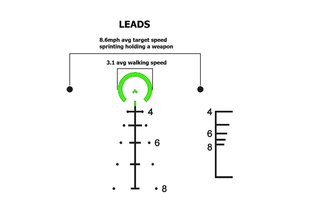
I have it with the red reticle, but it is also available in green. I also have a Trijicon 1-8x28 AccuPower Riflescope (Red MIL Segmented Circle Crosshair LED-Illuminated Reticle, Matte Black) on my SCAR 17. Here is its reticle:
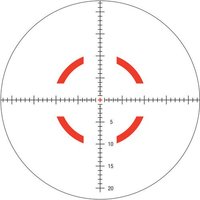
The AccuPower has been replaced by the Credo line which has the advantage of selectable red/green color. Even though the AccuPower requires a battery, I tend to prefer it to the ACOG. It has a diopter adjustment so it’s easier on the old eyes. It is a true 1X, so you can run it at 1X with both eyes open as you would a red dot. And since it is 1-8x it is more adaptable to long range.
The ACOG really is a true combat optic and is, IMHO, therefore more limited in its applications.
Here is a picture of the MCX with its ACOG and the SCAR with its AccuPower:
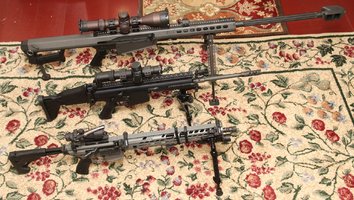
The gun in the back is the Barrett with its Vortex Razor HD Gen II 4.5-27x56 EBR-2C.
Here is what the ACSS Reticle looks like:

I have it with the red reticle, but it is also available in green. I also have a Trijicon 1-8x28 AccuPower Riflescope (Red MIL Segmented Circle Crosshair LED-Illuminated Reticle, Matte Black) on my SCAR 17. Here is its reticle:

The AccuPower has been replaced by the Credo line which has the advantage of selectable red/green color. Even though the AccuPower requires a battery, I tend to prefer it to the ACOG. It has a diopter adjustment so it’s easier on the old eyes. It is a true 1X, so you can run it at 1X with both eyes open as you would a red dot. And since it is 1-8x it is more adaptable to long range.
The ACOG really is a true combat optic and is, IMHO, therefore more limited in its applications.
Here is a picture of the MCX with its ACOG and the SCAR with its AccuPower:

The gun in the back is the Barrett with its Vortex Razor HD Gen II 4.5-27x56 EBR-2C.
Devils Paintbrush
NES Member
Was looking at some other things (future space fuel) and discovered something pertinent for tritium decay for the hardest of hard nerds.Every time I decide I want an ACOG, I can never figure out which one I want. They come "close" to what I want, but never hit the mark. Then, I start thinking about the cost, and the "advantage" of no batteries. After further consideration, I consider the no batteries feature to be the primary reason I don't get one. The tritium has a half-life of 10 years, then it starts to fade. The reality for me is that whatever I would mount the ACOG to will get taken to the range less than 10 times in the next 10 years, and will sit in the safe until one of my kids gets it. By then, the tritium will be faded and at or close to the end of it's life. I know the military likes them because they don't have to worry about that stuff.
Personally, I'd much rather have a low power variable that I can just replace the battery or remove it altogether if I want to preserve the electronics. If you don't need the 6x, 8x, 10x, etc. then just leave it at the lowest setting and don't worry about it.
If you decide to consider the LPVO instead of an ACOG, there are a large amount of options to look at and decide from.
Tritium decay
See also: tritiumVirtually all helium-3 used in industry today is produced from the radioactive decay of tritium, given its very low natural abundance and its very high cost.
Production, sales and distribution of helium-3 in the United States are managed by the US Department of Energy (DOE) Isotope Program.[26]
While tritium has several different experimentally determined values of its half-life, NIST lists 4,500 ± 8 days (12.32 ± 0.02 years).[27] It decays into helium-3 by beta decay as in this nuclear equation:
Among the total released energy of 18.6 keV, the part taken by electron's kinetic energy varies, with an average of 5.7 keV, while the remaining energy is carried off by the nearly undetectable electron antineutrino. Beta particles from tritium can penetrate only about 6.0 mm of air, and they are incapable of passing through the dead outermost layer of human skin.[28] The unusually low energy released in the tritium beta decay makes the decay (along with that of rhenium-187) appropriate for absolute neutrino mass measurements in the laboratory (the most recent experiment being KATRIN).
The low energy of tritium's radiation makes it difficult to detect tritium-labeled compounds except by using liquid scintillation counting.
Tritium is a radioactive isotope of hydrogen and is typically produced by bombarding lithium-6 with neutrons in a nuclear reactor. The lithium nucleus absorbs a neutron and splits into helium-4 and tritium. Tritium decays into helium-3 with a half-life of 12.3 years, so helium-3 can be produced by simply storing the tritium until it undergoes radioactive decay.
Tritium is a critical component of nuclear weapons and historically it was produced and stockpiled primarily for this application. The decay of tritium into helium-3 reduces the explosive power of the fusion warhead, so periodically the accumulated helium-3 must be removed from warhead reservoirs and tritium in storage. Helium-3 removed during this process is marketed for other applications.
For decades this has been, and remains, the principal source of the world's helium-3.[29] However, since the signing of the START I Treaty in 1991 the number of nuclear warheads that are kept ready for use has decreased[30][31] This has reduced the quantity of helium-3 available from this source. Helium-3 stockpiles have been further diminished by increased demand,[19] primarily for use in neutron radiation detectors and medical diagnostic procedures. US industrial demand for helium-3 reached a peak of 70,000 liters (approximately 8 kg) per year in 2008. Price at auction, historically about $100/liter, reached as high as $2000/liter.[32] Since then, demand for helium-3 has declined to about 6000 liters per year due to the high cost and efforts by the DOE to recycle it and find substitutes.
The DOE recognized the developing shortage of both tritium and helium-3, and began producing tritium by lithium irradiation at the Tennessee Valley Authority's Watts Bar Nuclear Generating Station in 2010.[19] In this process tritium-producing burnable absorber rods (TPBARs) containing lithium in a ceramic form are inserted into the reactor in place of the normal boron control rods[33] Periodically the TPBARs are replaced and the tritium extracted.
Currently only one reactor is used for tritium production but the process could, if necessary, be vastly scaled up to meet any conceivable demand simply by utilizing more of the nation's power reactors. Substantial quantities of tritium and helium-3 could also be extracted from the heavy water moderator in CANDU nuclear reactors.[19][34]
Tritium decay
GM-GUY
NES Member
Tritium is 12yr half-life and EMP immune. Fiberoptic assist in daylight works well.
With that said - I like the donut version - Top is 100 meters, middle of the donut is less than that or 200 meters....... My son has the chevron and he likes it - but of me (53yo) I'll stick with the donut.
With that said - I like the donut version - Top is 100 meters, middle of the donut is less than that or 200 meters....... My son has the chevron and he likes it - but of me (53yo) I'll stick with the donut.
You guys are funny. This is not a “what type of optics should I buy” thread. I am specifically asking about ACOGs.
Yes I know LPVO’s exist. Yes I know Red dots and magnifiers exist.
Yes I know LPVO’s exist. Yes I know Red dots and magnifiers exist.
I am still lost on what OP wants. for a tactical weapon with a task to hit human size targets any 3x or 4x prism based optic is best - an ACOG, or vortex, or primary arms, or AT3 - all got OK prisms to choose from with BDC reticles.
to hunt - there are plenty of lightweight 3-15 or 4-16 scopes.
for a competition or 3 gun there are other scopes, with 1- on the wide end - was discussed here in plenty of details. my interests are precision shooting and hunting only, so, i typically ignore red dots or prisms on rifles (but got one on the tavor now), so - i guess it is really up to OP to decide what interests him the best, and drive a decision from that angle.
Can’t disagree more. The tritium isn’t really needed. In fact, I’ve never seen tritium illumination in any ACOG I’ve used and I still think they’re great. Tritium is not what is useful. It’s the fiber optic that’s most useful.If you get an acog, just get a battery powered model acog. You don’t have to worry about tritium dying out.
At night if you’re using white light, the target will be illuminated and the reticle will be easily visible, if you’re using IR, you’ll either have a laser or be using a mini red dot for passive aiming. If you’re in a dark area and aiming out into an illuminated area, again the black reticle will stand out. And at dusk/dawn, the fiber optic is actually really good at collecting enough light, I usually had my fiber optic mostly covered with tape and just pealed it back as needed given the circumstances.
If the battery powered one still had fiber optic, with battery illumination as a backup, that would be great. But sadly they didn’t do it.
Can’t disagree more. The tritium isn’t really needed. In fact, I’ve never seen tritium illumination in any ACOG I’ve used and I still think they’re great. Tritium is not what is useful. It’s the fiber optic that’s most useful.
At night if you’re using white light, the target will be illuminated and the reticle will be easily visible, if you’re using IR, you’ll either have a laser or be using a mini red dot for passive aiming. If you’re in a dark area and aiming out into an illuminated area, again the black reticle will stand out. And at dusk/dawn, the fiber optic is actually really good at collecting enough light, I usually had my fiber optic mostly covered with tape and just pealed it back as needed given the circumstances.
If the battery powered one still had fiber optic, with battery illumination as a backup, that would be great. But sadly they didn’t do it.
I agree, I wish they did the ultimate concept of battery and fiber optic.
I have a older rco model that the tritium Is pretty dim but doesn’t really bother me since I’ll use the fiber optic 99% of the time.
cathouse01
NES Member
- Joined
- May 10, 2018
- Messages
- 2,438
- Likes
- 4,660
I wonder if one of you mechanically oriented fellows with a 3D printer could come up with something for the ACOG like what Chris Roenker makes for the Mepro M21. It's a really nice little attachment he calls the Reticule Enhancement Module 21 (REM 21). It’s a small LED light that fits right on the M 21 and solves the problem of not enough ambient light when you’re shooting from under cover. You can leave it off most of the time and only turn it on when your reticle washes out because of your target lighting being much brighter than what the sight is under. You can see it at his website M1BullPup | Peace Through Strength.
This is what it looks like on an M21:
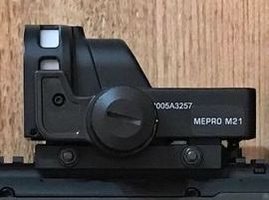
The REM 21 is the little L-shaped thing with the battery cap attached to the side of the M21. When you turn it on it shines a LED light on part of the light gathering fiber optic that surrounds the front go the M21. Would be harder to do for an ACOG due to the way the light gathering fiber is oriented on the optic.
This is what it looks like on an M21:

The REM 21 is the little L-shaped thing with the battery cap attached to the side of the M21. When you turn it on it shines a LED light on part of the light gathering fiber optic that surrounds the front go the M21. Would be harder to do for an ACOG due to the way the light gathering fiber is oriented on the optic.
Neat, I’ve actually dabbled with this concept for the ACOG, but didn’t get far because of the form factor and the time involved in 3D designing a housing.I wonder if one of you mechanically oriented fellows with a 3D printer could come up with something for the ACOG like what Chris Roenker makes for the Mepro M21. It's a really nice little attachment he calls the Reticule Enhancement Module 21 (REM 21). It’s a small LED light that fits right on the M 21 and solves the problem of not enough ambient light when you’re shooting from under cover. You can leave it off most of the time and only turn it on when your reticle washes out because of your target lighting being much brighter than what the sight is under. You can see it at his website M1BullPup | Peace Through Strength.
This is what it looks like on an M21:
View attachment 485158
The REM 21 is the little L-shaped thing with the battery cap attached to the side of the M21. When you turn it on it shines a LED light on part of the light gathering fiber optic that surrounds the front go the M21. Would be harder to do for an ACOG due to the way the light gathering fiber is oriented on the optic.
dhuze
NES Member
I have the green chevron in mine because I couldn't get red. I only paid $60 out of pocket. All you have to do is stay at a lot of hotels and collect the points. Then you trade the points for Cabela's gift cards and they get real inexpensive.
GM-GUY
NES Member
Can’t disagree more. The tritium isn’t really needed. In fact, I’ve never seen tritium illumination in any ACOG I’ve used and I still think they’re great. Tritium is not what is useful. It’s the fiber optic that’s most useful.
At night if you’re using white light, the target will be illuminated and the reticle will be easily visible, if you’re using IR, you’ll either have a laser or be using a mini red dot for passive aiming. If you’re in a dark area and aiming out into an illuminated area, again the black reticle will stand out. And at dusk/dawn, the fiber optic is actually really good at collecting enough light, I usually had my fiber optic mostly covered with tape and just pealed it back as needed given the circumstances.
If the battery powered one still had fiber optic, with battery illumination as a backup, that would be great. But sadly they didn’t do it.
Good point, forgot to mention this. I had a fox problem (he seems to have moved on - seriously not a SSS, I haven't seen him on any cams in a couple weeks), anyway I had him at 8PM on night, gun out and ready (yes using my AR for the fox) and the reticle was plainly visible - the only reason he lived was he didn't walk in front of the back stop he always did. My neighbor then my trailers were in the fire zone, I have a stack of telephone poles for a hunting stand project that he was heading for and veered off. This was a red fox with a red reticle - I had it on him the whole time - just waiting for him to reach the kill zone..........he didn't cooperate.
Later that night he came back, and I went out (now totally dark, no moon either - just stars) and he was gone. I did have my streamlight HL on the gun and was able to see my whole yard and pick up the reticle. Just for giggles, I can also see my 100 meter target that is back in the woods, reticle is visible without issue.
Last edited:
Share:

